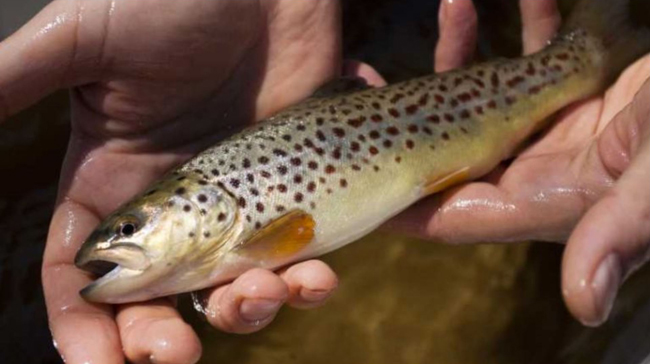
Researchers catch and tag fish in Carmans River (Apr. 25, 2012). Credit: Heather Wals.
— By Chris Gonzales, Freelance Science Writer, New York Sea Grant
Scientists tag alewife to get a more nuanced picture of its spawning migration
Stony Brook, NY, December 17, 2020 - Conventional wisdom tells us that migratory fish such as the alewife make a single journey to their freshwater spawning grounds in a year, then return to the sea. However, new data gathered from tagged fish says they might return to spawn several times per season.
Scientists successfully tagged 72 alewives with acoustic telemetry tags, a technology that enables scientists to track fish movements with receivers in marine and freshwater ecosystems. The acoustic tags actively transmit signals that are detected by compatible receivers positioned throughout the waterbody of interest. The acoustic tags are often larger and can be challenging to implant on sensitive fish such as alewife, but yield highly detailed movement information in both marine and freshwater environments. Scientists also tagged a larger number of fish with passive radio telemetry PIT tags, which are smaller and easier to implant, but limited to freshwater and brackish systems.
Of the total of 72 alewives that were tagged for acoustic telemetry, 27 made successful spawning migrations. Thirty disappeared off the tracking array, likely due to predation, such as by osprey or human anglers. Fifteen died or regurgitated the tag.
Of the 27 alewives that completed their migratory journeys, 11, or 41% , made multiple reversals back and forth from the spawning grounds in a season. Seven or 26% made the presumptive single migratory journey before returning to the sea. A number of PIT-tagged fish showed evidence of a different effect known as “fall back,” where the fish falls back and crosses the radio antenna where ecologists are counting them, which can result in double counting of fish.
The study took place on the Carmans River in Long Island, a small coastal river where dam removals and fish passages have reconnected new spawning grounds, making more habitat available for the first time in years.
Scientists call these movements back and forth within a single season “oscillation.”
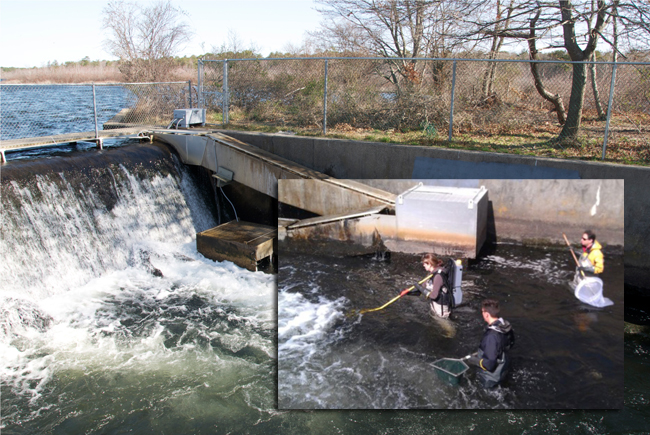
Scientists conduct fish sampling near the base of Hard’s Lake Dam, Carmans River, Long Island via an Alaska steeppass, a type of fish passage. The fish they caught were tagged. Credit: Matthew Sclafani, Cornell Cooperative Extension, Suffolk County.
More precise fish counts
“This research will inform future fish passage restoration and monitoring efforts,” said Kellie McCartin, who worked on the New York Sea Grant-funded project led by Michael Frisk, a fish ecologist at Stony Brook University (SBU)’s School of Marine and Atmospheric Sciences (SoMAS) and Matthew Sclafani, a marine educator with Cornell Cooperative Extension of Suffolk County and Adjunct Assistant Professor at SoMAS. McCartin, now a professor of marine biology at Suffolk County Community College, was a SBU SoMAS graduate student on the study and is the lead author of an article on this topic that appeared in Transactions of the American Fisheries Society.1
“Specifically, by making managers aware of multi-passage behavior, incorrect fishway counts can be avoided, which would otherwise result in the overestimation of alewife populations and, for this species of concern, have severe consequences.”
She and her research partners believe the oscillation behavior is a natural behavior that has as of yet remained undetected in coastal river ecosystems. Oscillation behavior was observed across all sexes, ages, and sizes of fish, though not all of the fish exhibited this behavior.
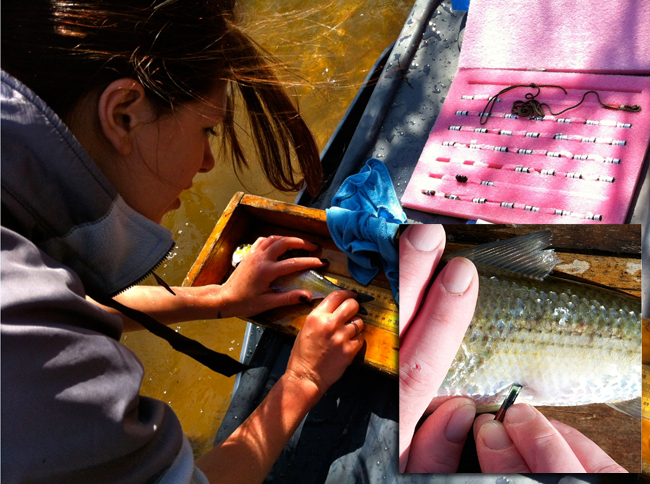
Kellie McCartin (at far left) and students Gwendolyn Nix and Michael Fogg from the School of Marine and Atmospheric Sciences, Stony Brook University, measure the length of juvenile alewife. Credit: Matthew Sclafani, Cornell Cooperative Extension, Suffolk County; (inset) Byron Young.
Historically, alewife comprise one of the most important fisheries in New York’s coastal region. Overfishing, habitat degradation, river dams, and the reduction of access to freshwater habitat have diminished their numbers. Most coastal states restrict anglers’ catch of alewife. As recently as 2017 alewife was proposed as a candidate for the endangered species list.
The life cycle of alewives
Since alewives spend part of their lives at sea, then ascend rivers to spawn, they play an important role in that they transport nutrients from the sea to those freshwater river ecosystems.
In recent years, a movement has been gathering strength to either remove dams or install fishways to help alewife and river herring reach freshwater habitat further in the interior.2 This research was funded by New York Sea Grant, which also awarded funds in 2016 to Karin Limburg, in a similar project, to study reconnected waters for eels and river herring after dam removal in the Hudson-Mohawk Watershed.3
Alewife ranges from North Carolina to Newfoundland, with several distinct stocks.4 The majority of their life is spent at sea. They mature between three and six years of age.
In the summer, the warming ocean signals them to migrate upriver. The migration along the East Coast continues in a progression beginning in late February further south and as late as late June further north.
In September 2020, Ms. Kayla Smith, a PhD candidate at SUNY College of Environmental Science and Forestry who worked on Karin Limburg’s NYSG-funded study, discussed her dissertation research in the Hudson-Mohawk watershed working with community groups to determine “barriers and bridges” to dam removal in order to restore historic diadromous fish runs (i.e., river herring and the American eel). “Diadromous” refers to the fact that these fish species require both inland and marine habitats to complete their life cycles. These species are in decline, in large part due to loss of access to vital riverine habitats that are now blocked by dams. The participation of stakeholders in workshops and interviews have proven invaluable to our understanding of community-level interest and concerns towards aquatic connectivity efforts in New York’s largest estuary. These conversations will ultimately help to inform state-level decision making for dam removal projects that benefit people and biodiversity.
New details uncovered
Information about spawning cycle iterations and durations helps habitat managers estimate population size and understand the health of the fish and their habitats. Thus, the new study represents a big shift in thinking about alewife spawning cycles.
The Carmans River is the second-largest river on Long Island, at about nine miles in length. A series of mill dams dating to the mid-1700s prevent alewife migration.
Investigators set up receivers to track fish entering and leaving the river to and from the sea.
On average, tagged alewives spent 48% of their time in the brackish region, 39% in freshwater (tidal and reconnected), and 13% in Great South Bay.
Spawning duration ranged from several hours to 18 days.
Natural falling back from the river to the bay, not due to tagging, could have dramatic implications for how alewives are studied and managed.
In Photos: Examining Tagging Methods to Evaluate the Success of Fish Passage Restorations for Alewife, American Eel and Brook Trout in the Carman's River
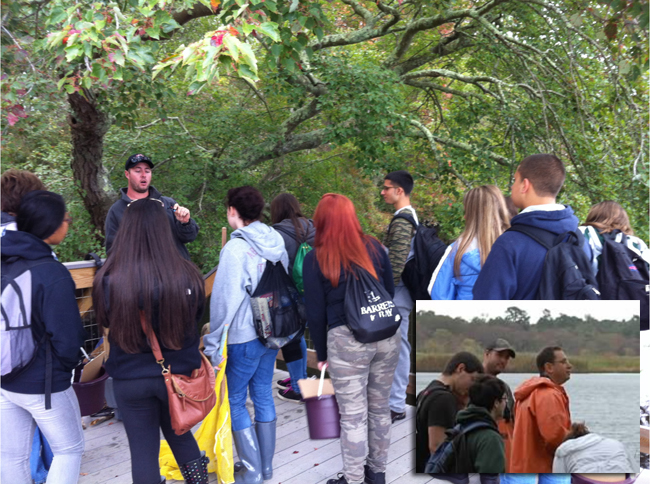
Corey Humphrey and Matthew Sclafani (inset, orange raincoat) of Cornell Cooperative Extension, Suffolk County, teach elementary and high school students in 2013-14 about their fish restoration project. Credit: Matthew Sclafani, Cornell Cooperative Extension, Suffolk County.
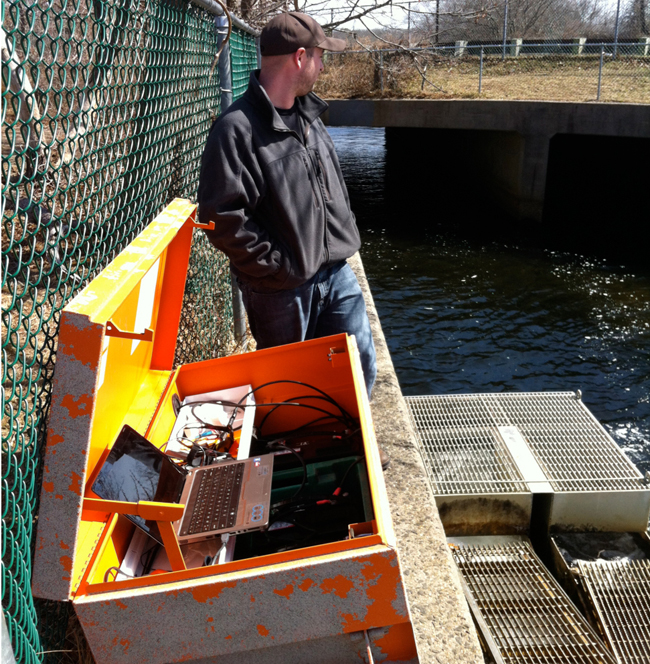
A video camera system helps scientists assess the number and timing of alewife that successfully pass through the top of the fish passage. Credit: Matthew Sclafani, Cornell Cooperative Extension, Suffolk County.
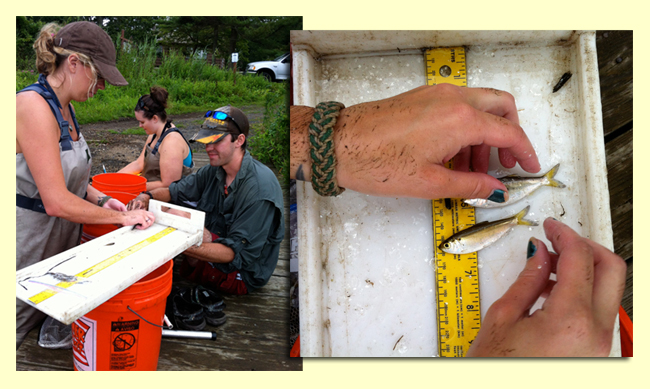
Kellie McCartin (at far left) and undergraduate students from the School of Marine and Atmospheric Sciences, Stony Brook University, measure the length of juvenile alewife. Credit: Matthew Sclafani, Cornell Cooperative Extension, Suffolk County.
References
1 McCartin, K., Jordaan, A., Sclafani, M., Frisk, M. & Cerrato, R. (2019). A New Paradigm in Alewife Migration: Oscillations between Spawning Grounds and Estuarine Habitats. Transactions of the American Fisheries Society 148:605–619.
2 It’s Fish vs. Dams, and the Dams Are Winning. The New York Times (January 20, 2020)
3 New York Sea Grant Research: Results and Impacts. New York Sea Grant (March 2020)
4 Palkovacs, E. P., D. J. Hasselman, E. E. Argo, S. R. Gephard, K. E. Limburg, D. M. Post, T. F. Schultz, and T. V. Willis. 2014. Combining genetic and demographic information to prioritize conservation efforts for anadromous Alewife and Blueback Herring. Evolutionary Applications 7:212–226.
More Info: New York Sea Grant
New York Sea Grant (NYSG), a cooperative program of Cornell University
and the State University of New York (SUNY), is one of 34 university-based
programs under the National Oceanic and Atmospheric Administration’s
National Sea Grant College Program.
Since 1971, NYSG has represented a statewide network of integrated
research, education and extension services promoting coastal community
economic vitality, environmental sustainability and citizen awareness
and understanding about the State’s marine and Great Lakes resources.
Through NYSG’s efforts, the combined talents of university scientists
and extension specialists help develop and transfer science-based
information to many coastal user groups—businesses and industries,
federal, state and local government decision-makers and agency managers,
educators, the media and the interested public.
The program maintains Great Lakes offices at Cornell University, SUNY
Buffalo, SUNY Oswego and the Wayne County Cooperative Extension office
in Newark. In the State's marine waters, NYSG has offices at Stony Brook
University in Long Island, Brooklyn College and Cornell Cooperative
Extension in NYC and Kingston in the Hudson Valley.
For updates on Sea Grant activities: www.nyseagrant.org has RSS, Facebook, Twitter, Instagram, and YouTube links. NYSG offers a free e-list sign up via www.nyseagrant.org/nycoastlines for its flagship publication, NY Coastlines/Currents, which is published quarterly. Our program also produces an occasional e-newsletter,"NOAA Sea Grant's Social Media Review," via its blog, www.nyseagrant.org/blog.